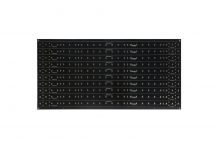Heavy copper printed circuit boards are in high demand and are widely used in various electronic industries. The PCBs have become one of the hottest PCBs with a good development prospect in the PCB industry.
Heavy copper PCB has another name, thick copper PCB, containing more than 3 ounces (oz) of copper on the inner or out layers of printed circuit boards. The circuit board with a copper thickness from 4 oz/ft2 to 20 oz/ft2 is also considered heavy copper PCB, while copper weights above 20 oz/ft2 and up to 200 oz/ft2 are referred to as extreme copper. With an appropriate substrate and thicker plating in the through-hole circuit, the copper weight makes these PCBs a reliable wiring platform. These boards are manufactured through a variety of etching and plating techniques. The goal is always to add copper thickness via plated holes and sidewalls.






















